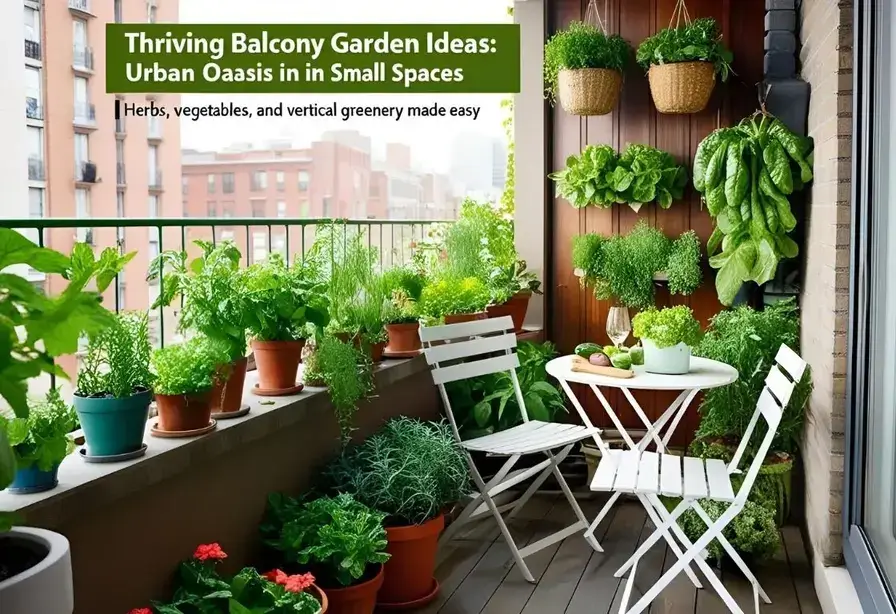Introduction:
Why Creating a Thriving Balcony Garden?
A thriving balcony garden isn’t just a hobby. It’s a fun and rewarding way to add life, color, and freshness to small urban spaces.
Picture Your Green Retreat
Imagine stepping outside and being greeted by lush plants, fragrant herbs, and vibrant flowers. Whether you’re a gardening expert or a complete beginner, this mini oasis is within reach.
Benefits Beyond Beauty
- Your balcony garden offers multiple rewards:
- A peaceful retreat from city noise and stress
- Natural air purification
- Fresh herbs and vegetables are steps from your kitchen
- Habitat for butterflies and beneficial pollinators
Inspired by NASA’s research on how indoor plants improve air quality.
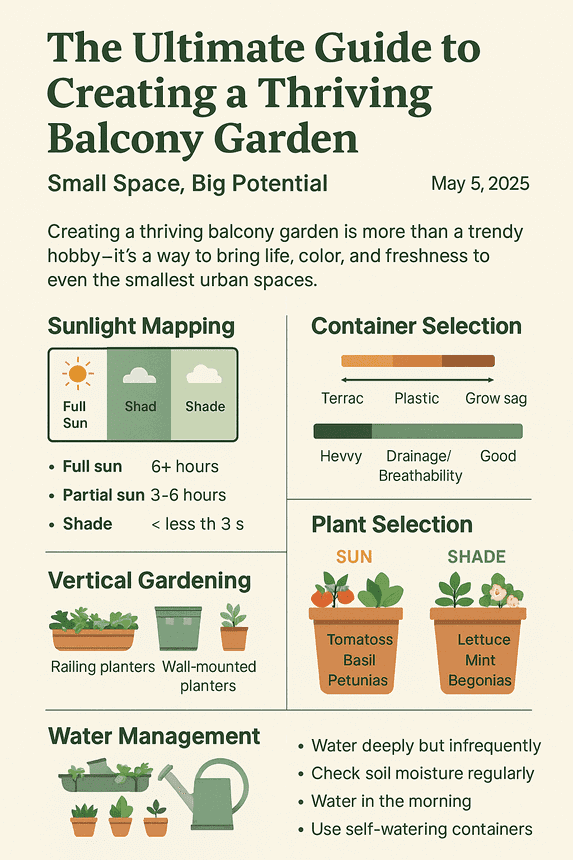
Need a Summary or Quiz for Class?
Download our free The Ultimate Guide to Creating a Thriving Balcony Garden with infographic, summary & mini-quiz
Table of Contents
Assessing Your Space: Know Your Balcony
Before purchasing a single plant, spend time understanding your balcony’s unique conditions. This critical first step will determine which plants will thrive in your space.
According to the EPA, balcony gardens can improve air quality and environmental health.
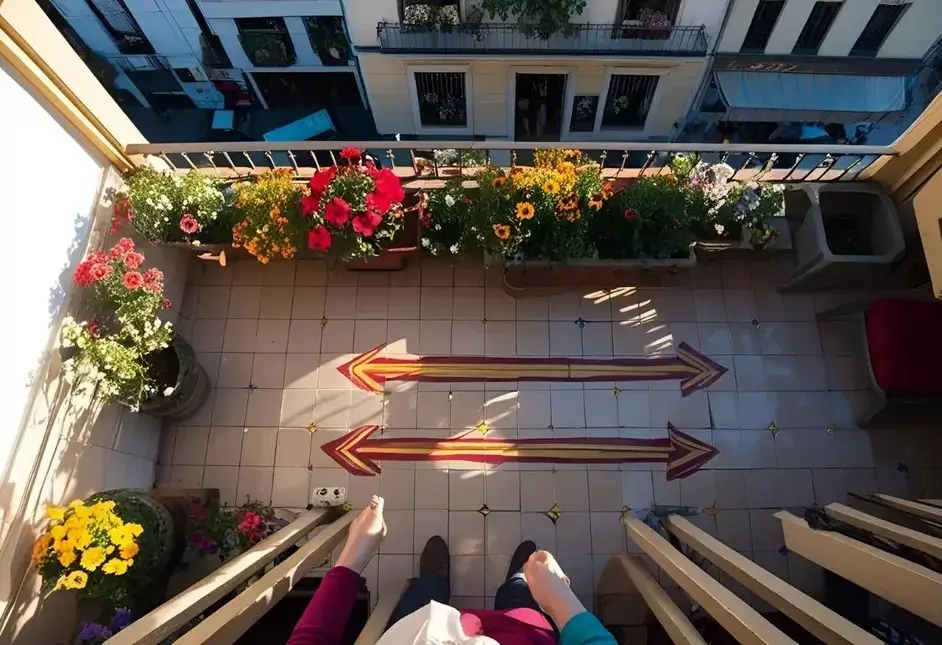
Sunlight Mapping
Observe how sunlight moves across your balcony throughout the day:
- Full sun (6+ hours direct sunlight): Ideal for vegetables, herbs like basil and rosemary, and many flowering plants
- Partial sun (3-6 hours direct sunlight): Perfect for herbs like mint and parsley, leafy greens, and many ornamental plants
- Full shade (less than 3 hours): Suitable for ferns, hostas, begonias, and shade-loving herbs
Take photos at different times of day for a week to create a sunlight map of your space. Note that light patterns change seasonally—a winter-shaded balcony might receive full sun in summer.
Refer to university gardening extension guides for soil mix formulas and best practices.”
Wind Exposure and Microclimate
Balconies, especially on higher floors, often experience stronger winds than ground-level gardens:
- Identify prevailing wind direction
- Note how the surrounding buildings create wind tunnels or shelter
- Consider temperature extremes throughout the year
For windy balconies, select sturdy plants with smaller leaves and flexible stems, and position taller containers to create windbreaks for more delicate specimens.
Weight Considerations
Safety comes first—ensure your garden doesn’t exceed structural limits:
- Check building regulations regarding weight restrictions
- Distribute heavy containers near load-bearing walls
- Consider lightweight alternatives: fiberglass or quality plastic containers, potting mix with perlite or vermiculite

Best Containers for a Thriving Balcony Garden
Choosing the right containers affects both plant health and visual appeal. Consider these factors when selecting your plant homes.
Container Materials
Each material offers different benefits:
- Terracotta/Ceramic: Excellent air circulation, beautiful aesthetic, but heavy and prone to cracking in freezing temperatures
- Plastic/Fiberglass: Lightweight, affordable, available in many styles, retains moisture well
- Metal: Sleek appearance but can overheat in direct sun, potentially damaging roots
- Fabric grow bags: Promote healthy roots through “air pruning,” lightweight, foldable, but dry out quickly
- Wood: Natural look, good insulation, but needs proper sealing to prevent rot.
Explore options like Smart Pots for space-saving and root-pruning benefits.
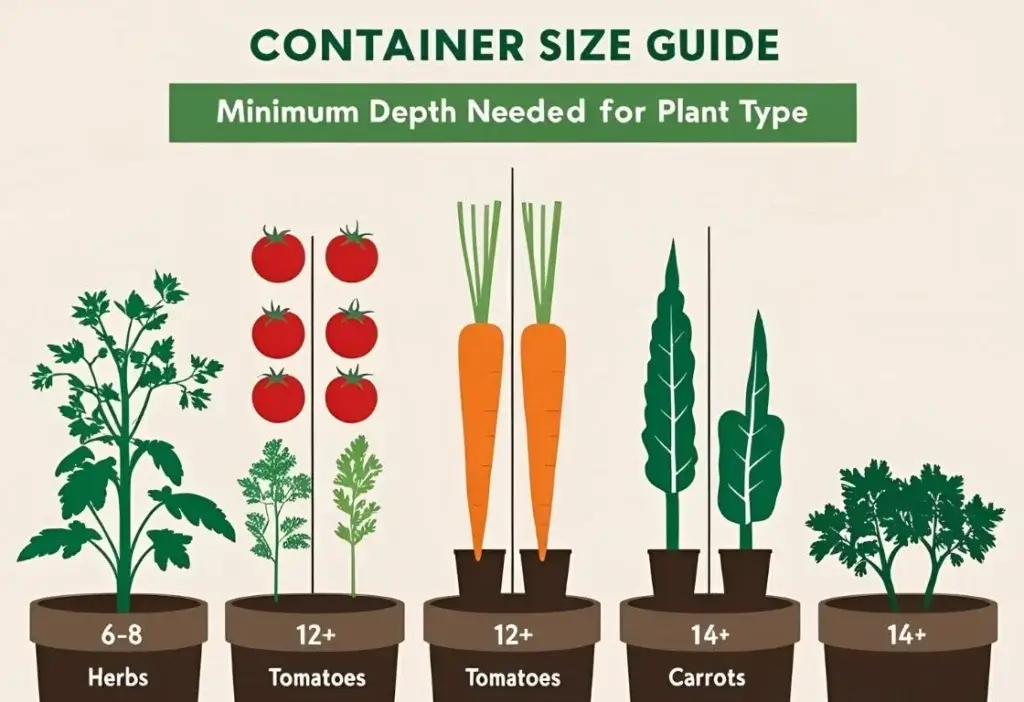
Size and Drainage Requirements
Match container size to plant needs:
- Minimum depths:
- Herbs and lettuce: 6-8 inches
- Annual flowers: 8-10 inches
- Vegetables like tomatoes: 12+ inches
- Root vegetables: 14+ inches
Every container needs:
- Multiple drainage holes (at least ¼ inch diameter)
- Saucers to catch excess water (empty regularly to prevent mosquito breeding)
- Proper spacing between containers for air circulation
Space-Maximizing Options
When floor space is limited, think vertically:
- Railing planters utilize unused perimeter space
- Wall-mounted pocket planters create living walls
- Hanging baskets add dimension at different heights
- Tiered plant stands multiply your growing area
- Stackable systems create vertical gardens in a minimal footprint
Soil and Nutrition: Foundation for Success
Container plants rely entirely on the growing medium you provide for nutrients, water, and root support.
Container-Specific Growing Medium
Container-Specific Growing Medium
Regular garden soil quickly compacts in containers. This leads to poor drainage and unhealthy roots.
Perfect Potting Mix Formula
Create a lightweight, nutrient-rich container mix with these components:
- 60% high-quality potting soil (foundation for plants)
- 20% compost (provides slow-release nutrients)
- 10% perlite or pumice (improves drainage)
- 10% coco coir or vermiculite (retains moisture)
Specialized Mixes
Different plants need adjusted formulas:
- Vegetable containers: Add extra compost (up to 30%)
- Succulents and cacti: Increase perlite to 20-30% for better drainage
- Moisture-loving plants: Add extra coco coir (up to 15%)
The RHS also provides helpful advice for beginner balcony gardeners.
Fertilizing Strategy
Container plants need more frequent feeding than garden plants because nutrients leach away with watering.
- Incorporate slow-release organic fertilizers at planting time
- Apply liquid fertilizer (half-strength) every 2-3 weeks during the growing season
- Reduce feeding during the fall and winter months
- Consider organic options like compost tea, seaweed extract, or diluted worm castings.
Plant Selection: Right Plants for Your Conditions
Success comes from matching plants to your specific balcony conditions. Here are recommendations for different situations.
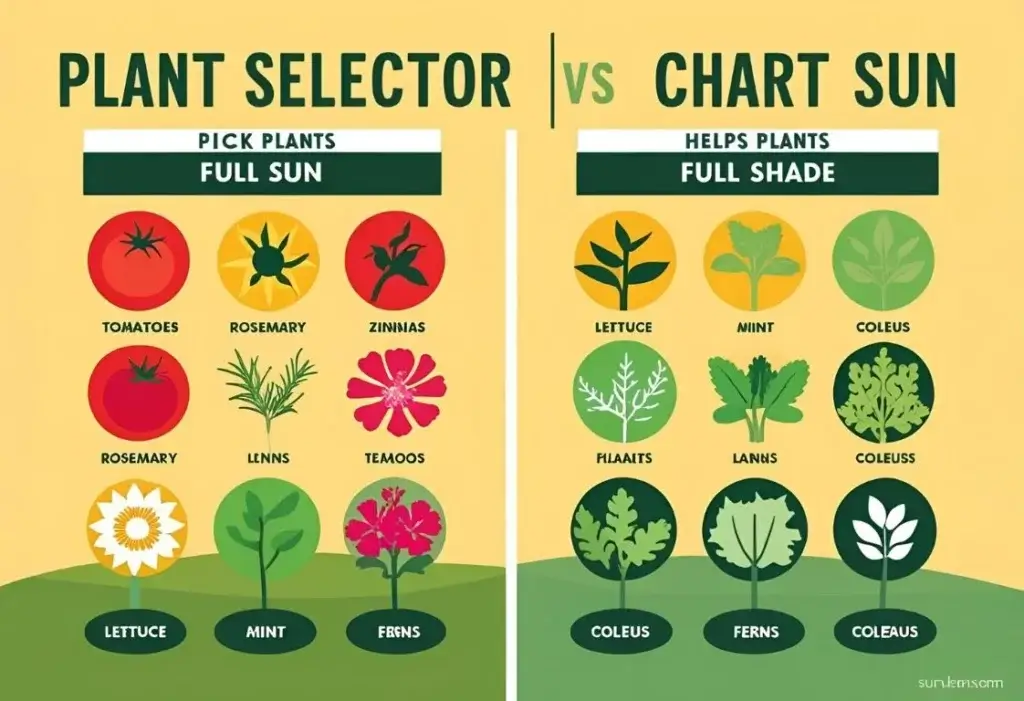
Sun-Loving Plants
For balconies receiving 6+ hours of direct sunlight:
Edibles:
- Tomatoes (compact varieties like ‘Patio’ or ‘Tiny Tim’)
- Peppers (both sweet and hot varieties thrive in containers)
- Strawberries (especially in hanging baskets)
- Mediterranean herbs (rosemary, thyme, oregano, sage)
Ornamentals:
- Petunias and calibrachoa for cascading color
- Zinnias and marigolds for pollinators
- Lavender for fragrance and drought-tolerance
- Succulents for low-maintenance beauty
Shade-Tolerant Options
For balconies with limited direct sunlight:
Edibles:
- Leafy greens (lettuce, spinach, arugula, kale)
- Shade-tolerant herbs (mint, parsley, cilantro)
- Root vegetables (radishes, carrots) with 4+ hours of sun
- Many asian greens (bok choy, tatsoi)
Ornamentals:
- Coleus for vibrant foliage
- Begonias for reliable flowers in shade
- Ferns for lush texture
- Caladiums for tropical drama
Climate-Appropriate Selections
Beyond light conditions, consider your local climate:
Hot, Dry Conditions:
- Drought-tolerant herbs and natives
- Succulents and cacti
- Heat-loving vegetables like eggplant
Cool, Damp Environments:
- Leafy greens year-round
- Cool-season flowers like pansies
- Woodland plants like hostas and ferns
Windy Balconies:
- Grasses with flexible stems
- Compact, dense plants with small leaves
- Low-growing spreading plants
Want to learn more about Which Substitutions Can Help Reduce Air Pollution? 15 Practical Swaps for Cleaner Air
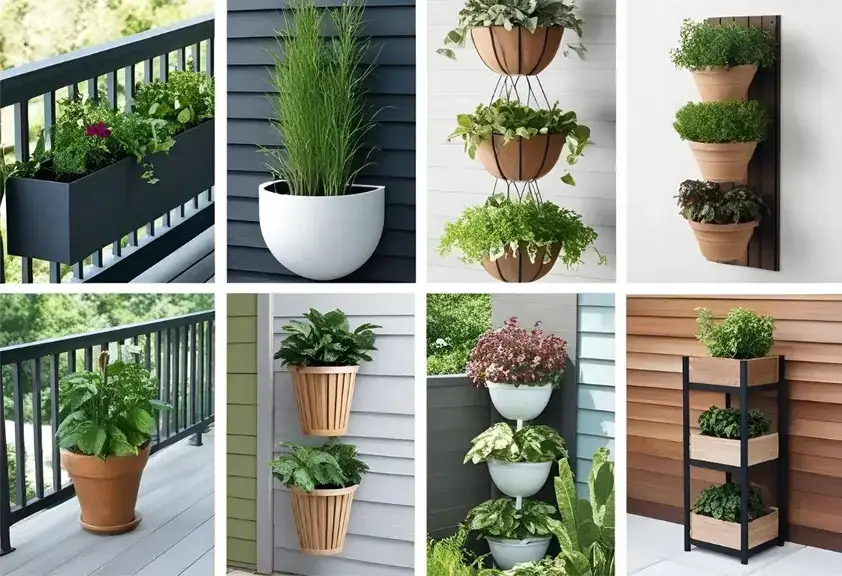
Vertical Gardening Tips for Small Balcony Gardens
When floor space is at a premium, growing upward multiplies your planting area.
Vertical Structures
Several systems transform vertical surfaces into growing space:
- Trellises and support frames for climbing plants
- Wall-mounted pocket planters or modular systems
- Repurposed items like shoe organizers or pallets
- Hanging basket systems at multiple heights
When installing vertical elements, ensure they’re securely anchored to withstand wind and weight when fully planted and watered.
Best Plants for Vertical Gardens
Some plants naturally excel in vertical settings:
Climbing Edibles:
- Pole beans and peas with natural climbing ability
- Indeterminate tomatoes trained as single stems
- Vining cucumbers on trellises
- Compact varieties of winter squash
Trailing Ornamentals:
- Ivy and pothos for lush cascades
- Wave petunias and calibrachoa for color
- Creeping thyme for texture and fragrance
- String-of-pearls succulents for their unique form

Water Management: Essential Techniques
Watering correctly presents unique challenges in container gardens, where soil dries quickly but drainage is critical.
Efficient Irrigation Practices
Develop consistent watering habits:
- Water deeply when the top inch of soil feels dry
- Apply water until it just begins to drain from the bottom holes
- Water in the early morning to reduce evaporation and fungal issues
- Adjust frequency based on temperature, wind, and container size
Some containers may need daily watering during the summer heat. Group plants with similar water needs together for efficient irrigation.
Water Conservation Systems
Implement systems to reduce water waste and maintenance:
- Self-watering containers with built-in reservoirs
- Drip irrigation with timers for consistent moisture
- Ollas (unglazed clay pots) buried in containers for slow water release
- Mulch layers to reduce evaporation
- Wicking systems made from recycled bottles
Maintenance Rhythms: Keeping Your Garden Thriving
Regular maintenance prevents small issues from becoming major problems. Establish simple care routines based on seasonal needs.
Daily and Weekly Care
Your 3-Minute Daily Routine: A quick daily check prevents small issues from becoming big problems. Spend just 2-3 minutes on:
- Visual inspection for wilting or stress signs
- Spot-watering plants that look thirsty
- Quick harvest of anything ready
Weekly Maintenance Session (15-30 minutes) Set aside a consistent time each week for:
- Complete Watering Check: Thoroughly water all containers that need it
- Grooming Tasks: Remove spent blooms and yellowing leaves
- Harvest Time: Collect ripe produce before it overripenes
- Pest Patrol: Examine leaf undersides and new growth
- Shape and Direct: Prune and train plants as needed
Seasonal Tasks
Each season brings different requirements:
Spring:
- Clean and sanitize containers
- Refresh the soil with compost
- Begin fertilization schedule
- Start warm-season plants
Summer:
- Increase watering frequency
- Provide shade during heat waves
- Monitor for pest populations
- Harvest regularly
Fall:
- Reduce fertilization
- Harvest and preserve herbs
- Plant cool-season crops
- Bring tender perennials indoors
Winter:
- Reduce watering for dormant plants
- Protect containers from freeze-thaw cycles
- Plan next season’s garden
- Start seeds indoors for spring
Troubleshooting Common Challenges
Even experienced gardeners encounter problems. Know how to identify and address common issues.
Pest Management
Urban balconies aren’t immune to pest issues:
- Prevent problems through good air circulation and proper watering
- Inspect plants regularly, especially under leaves
- Use organic methods first: strong water spray for aphids, insecticidal soap for soft-bodied insects, and neem oil (a natural plant extract) for multiple pests. To buy from Amazon.
- Introduce beneficial insects like ladybugs for natural control
Use gentle, organic pest control like insecticidal soap (plant-safe spray). To buy from Amazon.
Environmental Stresses
Urban environments create unique challenges:
- Heat stress: Use shade cloth during peak summer, mulch the soil surface, and water deeply in the early morning
- Wind damage: Install windbreaks; select wind-resistant plants; secure climbing plants firmly
- Pollution: Rinse foliage periodically; select pollution-tolerant species
Conclusion: Your Evolving Oasis
Creating a thriving balcony garden is a journey, not a one-time project.
Start small with a few containers of your favorite plants.
Observe, learn, and expand as your confidence grows.
Remember that even experienced gardeners face challenges—these aren’t failures but valuable learning experiences.
Your balcony garden can become a personal sanctuary that changes with the seasons, provides fresh harvests, and offers a peaceful retreat from urban living. The skills you develop will grow alongside your plants, giving satisfaction and beauty year after year.
How to Switch to Renewable Energy at Home: A Beginner’s Step-by-Step Guide (2025)
Ready to begin? Start by observing your space this week, noting sunlight patterns and envisioning which area might be perfect for your first containers. Take “before” photos to appreciate the transformation you’ll create in the coming months. Your urban oasis awaits!
Want to learn more about Light Pollution Drawing? Explore how light affects urban biodiversity.
Download Free Balcony Garden Infographic + Quiz [PDF]
FAQs About Creating a Thriving Balcony Garden
Q: What are the best plants for creating a thriving balcony garden?
A: The best plants depend on sunlight and climate. Herbs like basil, mint, rosemary, tomatoes, lettuce, and begonias are great balcony choices.
Q: How do I start creating a thriving balcony garden as a beginner?
A: Start by mapping sunlight, choosing containers with good drainage, using a nutrient-rich potting mix, and selecting low-maintenance plants.
Q: Can I grow vegetables in a small balcony garden?
A: Yes! Compact vegetable varieties like cherry tomatoes, peppers, lettuce, and radishes grow well in containers and thrive in balcony spaces.
Q: How much sunlight is needed for a thriving balcony garden?
A: Most vegetables and flowering plants need 6+ hours of direct sunlight. Leafy greens and herbs can do well with 3–6 hours of partial sun.
Q: What containers are best for balcony gardening?
A: Use lightweight containers like plastic or grow bags for ease, or terracotta for breathability. Ensure they have proper drainage holes.
Q: How can I maintain my balcony garden with a busy schedule?
A: Set up a simple routine: check plants daily for water needs, use self-watering containers, group plants by water requirements, and fertilize monthly.
Ready to Start Your Balcony Garden Journey?
Begin with a simple sunlight assessment this week. Take photos at different times of day to create your sunlight map, then return to this guide to select your perfect plants and containers.
Share your balcony garden progress in the comments below!”
Want to learn more about Balcony Garden?
- Balcony Vegetables for Beginners: Transform Your Small Space into a Green Paradise
- Balcony Vegetable Garden Kit: Everything You Need to Start Growing at Home
- DIY Balcony Vegetable Garden: Best Tips for Beginners 2025
About the Author
Soumen Chakraborty is an environmental writer who is passionate about sustainable solutions. He has researched and written about environmental issues for two years, breaking complex topics into practical, actionable insights.
“Every small action matters in protecting our planet.”
Loved these balcony garden tips? 🌱
👉 Share this with your friends on Facebook, use #MyBalconyGarden, Pinterest, or Twitter, and spread the green!
🛒 Disclosure: As an Amazon Associate, I earn from qualifying purchases at no extra cost to you. Your support helps keep this site running. Thank you!
What type of balcony garden are you planning to create? Share your ideas in the comments below!

